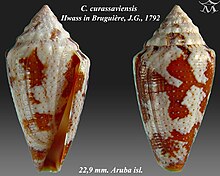| Conus curassaviensis | |
|---|---|

| |
| Apertural and abapertural views of shell of Conus curassaviensis Hwass in Bruguière, J.G., 1792 | |

| |
| Conservation status | |
 Near Threatened (IUCN 3.1) | |
| Scientific classification | |
| Domain: | Eukaryota |
| Kingdom: | Animalia |
| Phylum: | Mollusca |
| Class: | Gastropoda |
| Subclass: | Caenogastropoda |
| Order: | Neogastropoda |
| Superfamily: | Conoidea |
| Family: | Conidae |
| Genus: | Conus |
| Species: | C. curassaviensis |
| Binomial name | |
| Conus curassaviensis Hwass in Bruguière, 1792 | |
| Synonyms | |
| |
Conus curassaviensis is a species of sea snail, a marine gastropod mollusk in the family Conidae, the cone snails and their allies.
Like all species within the genus Conus, these snails are predatory and venomous. They are capable of "stinging" humans, therefore live ones should be handled carefully or not at all.
Distribution
This species occurs in the Caribbean Sea off Aruba, Netherlands Antilles.
Description
The maximum recorded shell length is 51 mm.
Habitat
Minimum recorded depth is 2 m. Maximum recorded depth is 9 m.
References
- Petuch, E. (2013). "Conus curassaviensis". IUCN Red List of Threatened Species. 2013: e.T192535A2111152. doi:10.2305/IUCN.UK.2013-1.RLTS.T192535A2111152.en. Retrieved 25 April 2024.
- ^ Conus curassaviensis Hwass in Bruguière, 1792. Retrieved through: World Register of Marine Species on 27 March 2010.
- ^ Welch J. J. (2010). "The "Island Rule" and Deep-Sea Gastropods: Re-Examining the Evidence". PLoS ONE 5(1): e8776. doi:10.1371/journal.pone.0008776.
- Tucker J.K. & Tenorio M.J. (2009) Systematic classification of Recent and fossil conoidean gastropods. Hackenheim: Conchbooks. 296 pp.
- Puillandre N., Duda T.F., Meyer C., Olivera B.M. & Bouchet P. (2015). One, four or 100 genera? A new classification of the cone snails. Journal of Molluscan Studies. 81: 1–23
External links
- The Conus Biodiversity website
- Cone Shells – Knights of the Sea
- "Tenorioconus curassaviensis". Gastropods.com. Retrieved 15 January 2019.
| Taxon identifiers | |
|---|---|
| Conus curassaviensis | |
This Conus-related article is a stub. You can help Misplaced Pages by expanding it. |